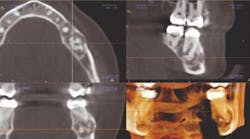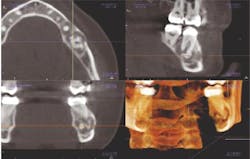A radiologist's view of in-office CBCT: Interview with Jeffery B. Price, DDS, MS
Dr. Shellard discusses imaging trends in dentistry with an oral radiology specialist
When Jeffery B. Price, DDS, began his dental career, it was as a general and restorative dentistry practitioner. However, when a bicycling accident affected his right hand, he changed course by going back to school and completing his residency in oral radiology. Thanks to his decades of dental experience, Dr. Price brings a unique perspective to the field of radiology. Recently, I had the chance to sit down with Dr. Price to talk about his perspective and trends in CBCT imaging.
Dentists are bringing CBCT technology in-office rather than referring patients to imaging centers. What are some ways in-office CBCT is changing the way dentists practice?
The first change is that dentists have had to step up their game to become, in some ways, more "medical-like." In other words, dentists are challenged to become more technology driven, keep focused on the patient, and not allow the technology to overwhelm the patient. When you're working with small digital images-like periapical images-it's easy to talk to your patients about what's on the computer monitor since there is only one image. When you move into the world of CBCT, it's higher tech and delivers a real "wow" factor since there are literally hundreds of reconstructed images.
The second major change comes in interpreting the images. You have to take the time to understand the anatomy, even if you are using a machine that allows for focused volume views, such as the CS 9300 (Carestream Dental), which you're familiar with. Take the time to learn the science, the 3-D radiographic anatomy and radiographic interpretation, radiation dosimetry, and 3-D imaging.
Above: Images from the Carestream Dental CS 9300
What are patients' expectations for CBCT, if any?
Patients begin to expect more with this technology, and it elevates the esteem the patient has for the dentist and the practice. This is also a double-edged sword, since the practice and dentist have to live up to higher expectations. Patients see the practice investing in the new technology, so they will make an association that the dentist's technical skills are just as technically advanced as the imaging.
With more doctors using in-office CBCT systems, what kind of safeguards and regulations can we expect to see?
As the use of CBCT increases, we will see more practice guidelines issued by professional organizations. In 2012, the American Association of Oral and Maxillofacial Radiology updated its 2002 guidelines for use with implant planning. The association recommended using CBCT for routine dental implant planning. In May of 2015, we worked with the American Association of Endodontists to issue a new set of guidelines concerning CBCT. I think that if endodontists, as well as general practitioners, read it carefully, they will see that the guidelines are recommending the increased use of limited volume, high resolution CBCT imaging in properly selected cases.
Edward Shellard, DMD, has more than two decades of clinical and executive experience in the dental industry. Since joining Carestream Dental in February 2008, Dr. Shellard has driven global marketing strategy and product development efforts for the latest innovations in dental and practice management technology.
Jeffery B. Price, DDS, MS, is a diplomate of the American Board of Oral and Maxillofacial Radiology. He is currently an associate professor of oral and maxillofacial radiology and director of oral and maxillofacial radiology at the University of Maryland School of Dentistry. In addition, he is an adjunct associate professor at the University of North Carolina School of Dentistry. Price practiced general and adult restorative dentistry in Hendersonville, North Carolina, for 24 years.
ALSO BY DR. SHELLARD: Does your practice technology need a checkup?


